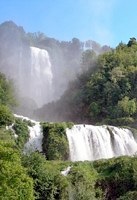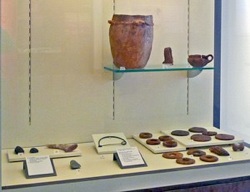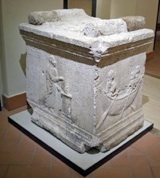


This waterfall, which is one of the highest artificial waterfalls in Europe, is near the village of Marmore, about 10 km east of Terni. It has a drop of some 165 meters divided into three falls, the first and highest of which has a drop of some 83 meters.
Roman History
According to Cicero, the people of Rieti retained him in 54 BC:
-
“... to plead their cause against the people of Interamna before the Consul and ten commissioners, because the Veline Lake, which had been drained by Manius Curius by cutting away the mountain, flowed into the Nar, by which means the famous Rosia has been reclaimed from the swamp, though still fairly moist” (‘Letter to Atticus’, 4:15:5)
Manius Curius Dentatus had apparently opened an artificial channel to divert the water of the lake over a precipice and into the Nera, forming the so-called Cascata delle Marmore. This work is usually said to have been carried out in Dentatus’ period as Censor in 272 BC.
Pliny the Elder described how the Sabini (Sabines)
-
“... dwell on the dew-clad hills in the vicinity of the Lakes of the Velinus” (‘Natural History’, 3:17)
These lakes (which included what is now the Lago di Piediluco) were the consequence of the diversion of the Velino river. Pliny continued:
-
“The Nar (Nera), with its sulphureous waters, exhausts these lakes, and, descending from Mount Fiscellus (Monte Fiscello), unites with them near... Reate (Rieti), and then directs its course towards the Tiber, into which it discharges itself”.
Unfortunately, this intervention sometimes caused the Nera to flood, and the inhabitants of Terni and Rieti had frequent legal disputes about the regulation of the Velino. In 54 BC (as mentioned above) the matter came before the Roman senate:
-
✴Marcus Tullius Cicero represented Rieti; and
-
✴Francesco Angeloni (referenced below, at pp. 24-5) suggested Aulus Pompeius, who was commemorated in an inscription (CIL IX 4213, 1st century BC, now in the Museo Archeologico,) as having saved Interamna from danger, might have represented Terni.
However, it is not clear that danger was averted on this occasion, since the outcome of the case is unknown. Indeed, as William Heitland (referenced below, at p. 234) observed:
-
“As [Cicero] refers to the case with great pride [in his letter to Atticus, above], we may presume that he won it.”
Gaius Cornelius Tacitus recorded a proposal of the Senate in Rome to regulate the Nar and the outlets from the lake in order to reduce the risk of floods from the Tiber in 15 BC:
-
“[The following] arguments were used by the inhabitants of Interamna. The most fruitful plains of Italy, they said, would be destroyed if the river Nar (for this was the plan proposed) were to be divided into several streams and overflow the country. Nor did the people of Reate remain silent. They remonstrated against the closing up of the Veline lake, where it empties itself into the Nar:
-
‘as it would burst in a flood on the entire neighbourhood. Nature had admirably provided for human interests in having assigned to rivers their mouths, their channels, and their limits, as well as their sources. Regard, too, must be paid to the different religions of the allies, who had dedicated sacred rites, groves, and altars to the rivers of their country. Tiber himself would be altogether unwilling to be deprived of his neighbour streams and to flow with less glory.’
-
Either the entreaties of the colonies, or the difficulty of the work or superstitious motives prevailed, and they yielded to Piso's opinion, who declared himself against any change” (Annals I:79).
Later History
Over time, the ancient canal that drained the Rieti plain became increasingly ineffective. In 1422, Pope Gregory XII commissioned the building of a new canal in order to restore the original flow of the river. However, problems with flooding persisted:
-
✴in 1545, Pope Paul III sent Antonio da Sangallo il Giovane to open another canal;
-
✴in 1598, Pope Clement VIII sent Carlo Maderno and Giovanni Fontana to enlarge this canal and to build a structure to regulate the flow of water.
Finally, in 1787, Pope Pius VI sent Andrea Vici to further modify the structure. This project was successful and gave the waterfall its current appearance. It became a popular stop for English aristocrats on “the Grand Tour”.
Industrialisation
The waterfall started to be used for its motive power in the 19th century: for example, from 1896, it served the new Acciaierie di Terni (steel works).
In 1929, the falls were adapted to form the hydroelectric complex that fuels much of Terni's industrial complex (and indeed much of Central Italy). This means that the spectacle of the falling water can only be seen intermittently: the official website of the Cascata della Marmore gives the times at which the falls will be in operation.
Archeology
The Museo Archeologico contains a number of finds from sites near the Cascata della Marmore.
Neolithic Finds (17th - 10th centuries BC)

These finds in Room I include:
-
✴a large bronze bow fibula found in 1914 in the so-called Galleria del Toro; and
-
✴a conical vessel filled with sand and ashes that was discovered in the 1970s in the Cor delle Fosse, with other items, including loom weights and bobbins, that were found nearby.
Altar of Neptune (1st century BC)

-
✴a standing figure of the naked Neptune between two dolphins ; and
-
✴the donor in the act of making a sacrifice to him at an altar similar to this one (illustrated here).
The relief on the side , which is also illustrated here, shows the ferryman and a passenger, perhaps crossing the Velino.
Read more:
W. E. Heitland, “The Roman Republic, Volume 3” (1909, republished in 2014) Cambridge
F. Angeloni, ‘Storia di Terni’ (1646, republished in 2002) Arone
Return to Monuments in Terni.
Return to the Drives from Terni.

